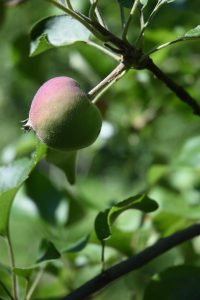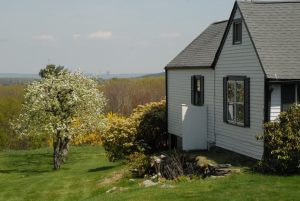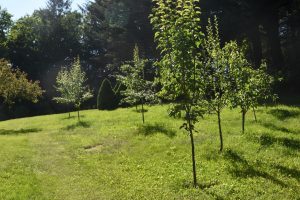“Guess how many fruit trees I planted this year?”
That was the challenge Peter Montgomery laid down not long into our chat on the back porch (the one overlooking his own backyard orchard) of his Warren home. I thought that I’d be daring, so I ventured the “two dozen trees?” guesstimation. I wasn’t even close.
“One thousand, fifty trees,” he proudly proclaimed.
Actually, he served as a consultant for the planting of most of those fruit trees, helping nascent orchards across Connecticut and into Rhode Island become established in his capacity as an absolutely outspoken proponent for growing your own fruit trees. You’ve heard of Johnny Appleseed? Well, Peter Montgomery is the most recent iteration, with an emphasis on fruit that you might not be able to find at your local supermarket.
If Montgomery hadn’t encountered an Asian pear, this region might be lacking a whole lot of lip-smacking, homegrown fruit. Back when he was working in California, he frequented farmers’ markets and came home with a newly attuned taste for that relatively arcane fruit. Don’t judge Asian pears on the mushy version found in northeastern supermarkets, he cautions, because those pathetic representatives don’t compare to the tree-ripened nuggets of crisp, juicy goodness he produces in his two-acre backyard.

Striving to rediscover that taste was the impetus that started the orchard on his Warren property in 2005. “If you haven’t sunk your teeth into an Asian pear from your own tree, you are in for an experience,” he says provocatively. But he isn’t the type to settle for a couple of lone trees. He currently hosts 41 fruit trees, including 11 Asian pear trees, nine apple trees, and a smattering of perry pears, European pears, apricots, nectarines, peaches, and sweet cherries.
Despite less than ideal conditions (the wrong pH and soggy soil), the only disappointments have been the European pears that have refused to produce a crop to date and the cherry trees, which also failed to fulfill their destiny – a lack that Montgomery blames on the humidity in our climate.
He might actually bristle at the Johnny Appleseed comparison due to the misleading nickname. Contrary to the popular folktales, John Chapman (alias Johnny Appleseed, 1774-1845) did not sling handfuls of apple seeds across the countryside. In truth, Chapman wisely planted nursery orchards for his neighbors and taught them to produce nursery stock for sale to nurture further orchards.
As Montgomery points out, seed is the least effective way to grow an apple tree and the results will not produce the same apple as the parent. Not only are apples complex hybrids at this point, but flowers must be pollinated by another variety to produce fruit. Instead, he plants whips that result from grafts. That way, the resulting fruit will mirror its parent. The key to success is planting the tree with the graft union placed above the soil level. He recommends selecting semi-dwarf root stock for a robust, quickly maturing tree that produces fruit within easy harvesting reach. Whereas standard apples mature to 30-35 feet tall, a semi-dwarf tree tops out at a convenient 10-12 feet.

Although it was Asian pears that jumpstarted Montgomery’s orchard ambitions, apples followed closely on their heels. Supermarkets typically focus primarily on a handful of apple varieties selected for their ability to survive shipment from a distant source to your shopping cart. Unfortunately, they aren’t necessarily the tastiest examples of this fruit. Instead, Montgomery focuses on more delectably flavorful apples that are not necessarily great candidates for transporting far and wide. They make a good argument for growing in your own backyard, some of his favorites being Mutsu, Arkansas Black, and Roxbury Russet.
But all sorts of factors might come into play when selecting the right fruit for you. Montgomery is fond of hard cider, which is why he turned to perry pears. The endeavor proved so fruitful, in fact, that he pursued courses in cider-making and received certification from Cornell University’s Cider & Perry Academy. But cider-making is just one of the delights of growing your own fruit and he urges potential home orchardists to explore fruit that’s geared toward their fancies – for example, apples are bred specifically for fresh eating, cooking, sauces, salads, beverage, pies, and storage purposes. Select according to your taste.
There are factors beyond personal preferences that should guide your selection. Most importantly, fruits must be able to survive in Connecticut’s plant hardiness zones, which range from the chillier 5b in the northwest corner to the balmier 7a along most parts of the shoreline. (Visit planthardiness.ars.usda.gov/PHZMWeb for more information on your particular zone.)
Sunlight and soil are also key. No matter where you live in the state, we have no problem providing the 500-plus hours of temperatures below 45 degrees F that apples need annually. (“Most fruit trees also prefer 8 hours or more of sunlight,” Montgomery suggests.) But you would be wise to check your soil pH, which varies considerably in our region. Montgomery’s soil pH in Warren is 5.2, which is more acidic than the 6.8 ideal pH for apples. However, by amending the soil, he has been able to conquer that hurdle. Good drainage is also critical, a lesson Montgomery learned the hard way when he sited his initial trees in a gully. “A south-facing slope is optimal,” he recommends. Of course, other factors are involved as well, with pruning being key to a tree’s ultimate success. It’s a science. Montgomery delves into the details when teaching courses on backyard orcharding through EdAdvance, and takes immense pride in the fact that his students (and potential home orchardists) count in the hundreds. Not unlike Johnny Appleseed, he is spreading word of the scrumptious goodness of homegrown fruit.
On a much larger scale, Linda Allard planted her own orchard 20 years ago, when she built her home in Litchfield County. At the time, the head fashion designer for Ellen Tracy was traveling back and forth from New York City, but she felt strongly that cultivating her own fruit was an important facet of the country life experience. An accomplished cook and author of Absolutely Delicious! (Random House, 1994), Allard planted more than 135 apple trees on her north-facing slope, with some peach trees represented as well. It’s about an acre of apples and, on a good year, she can press 200 gallons of fresh cider.
Last year was not a good year and, despite the fact that she grows nine different apple varieties including Liberty, Golden Russet, Winesap, Northern Spy, and Cortland, the crop was a major disappointment across the board. But Allard has noticed that her trees tend to alternate years of productivity. So this year she might be enjoying a bounty.

Home orchards run the gamut. And interest is definitely on the upswing. Richard Crouch, who runs the landscape department for Kent Greenhouse & Gardens, has noticed that the nursery is selling a lot of fruit trees. Apple trees are a favorite, followed by peach trees.
Acquiring a couple of fruit trees is a valid starting point. Whether you go whole hog or have just inherited a gnarly old apple that came with your property and are striving to prune it into prime again, it’s all incredibly rewarding and enticing. After all, wasn’t it an apple that baited the prototypical gardener to take a bite in the beginning? Adam had no idea what he was starting…
Tovah Martin is an author, lecturer, and garden/lifestyle writer – to say nothing of a plant expert. Her latest book is The Garden in Every Sense and Season
(Timber Press, 2018).








More Stories
Over 50, Underestimated: The Grandfluencers Redefining Age on Social Media
Building Resilient Businesses: Strategies for Success
Summer Means Convertibles